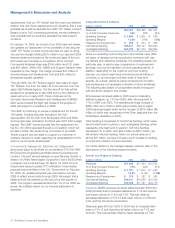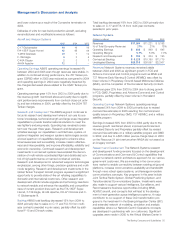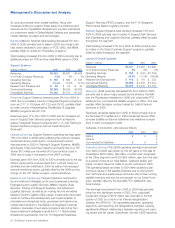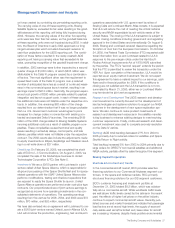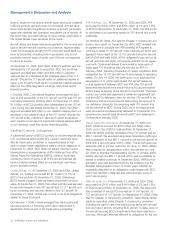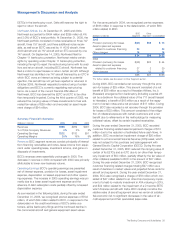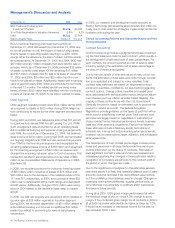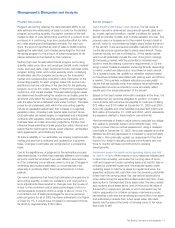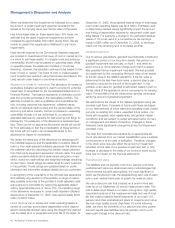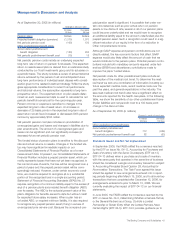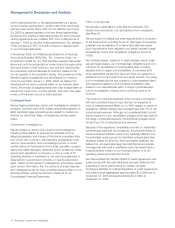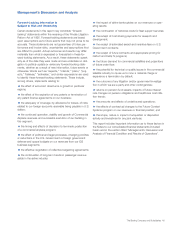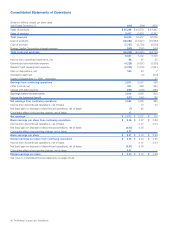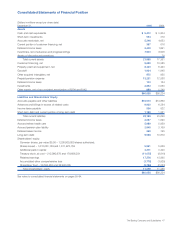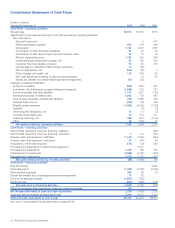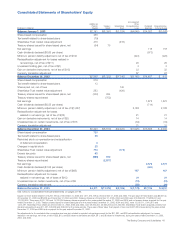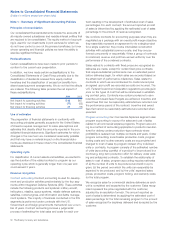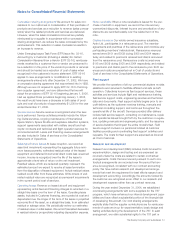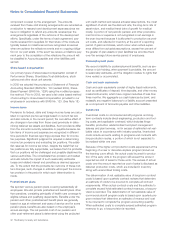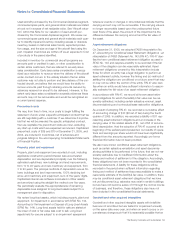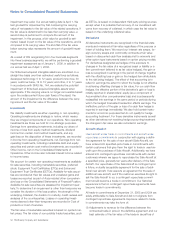Boeing 2005 Annual Report Download - page 46
Download and view the complete annual report
Please find page 46 of the 2005 Boeing annual report below. You can navigate through the pages in the report by either clicking on the pages listed below, or by using the keyword search tool below to find specific information within the annual report.Management’s Discussion and Analysis
when a general partner, or the general partners as a group,
control a limited partnership or similar entity when the limited
partners have certain rights. EITF 04-5 is effective as of June
29, 2005 for general partners of all new limited partnerships
formed and for existing limited partnerships for which the part-
nership agreements are modified. EITF 04-5 is effective as of
January 1, 2006 for all other limited partnerships. Our adoption
of the provisions of EITF 04-5 will not have a material impact
on our financial statements.
In November 2004, the FASB issued Statement of Financial
Accounting Standard (SFAS) No. 151, Inventory Costs—an
amendment of ARB No. 43. This Standard requires that certain
abnormal costs be recognized as current period charges rather
than as a portion of the inventory cost, and that fixed produc-
tion overhead costs be allocated to inventory based on the
normal capacity of the production facility. The provisions of this
Standard apply prospectively and are effective for inventory
costs incurred after January 1, 2006. While we believe this
Standard will not have a material effect on our financial state-
ments, the impact of adopting these new rules is dependent on
events that could occur in future periods, and cannot be deter-
mined until the event occurs in future periods.
Contingent Items
Various legal proceedings, claims and investigations related to
products, contracts and other matters are pending against us.
Most significant legal proceedings are related to matters cov-
ered by our insurance. Major contingencies are discussed
below.
Government investigations
We are subject to various U.S. Government investigations,
including those related to procurement activities and the
alleged possession and misuse of third-party proprietary data,
from which civil, criminal or administrative proceedings could
result or have resulted. Such proceedings involve, or could
involve claims by the Government for fines, penalties, compen-
satory and treble damages, restitution and/or forfeitures. Under
government regulations, a company, or one or more of its
operating divisions or subdivisions, can also be suspended or
debarred from government contracts, or lose its export privi-
leges, based on the results of investigations. We believe, based
upon current information, that the outcome of these disputes
and investigations will not have a material adverse effect on our
financial position, except as set forth in Note 24 to our
Consolidated Financial Statements.
Other contingencies
We are also a defendant in suits filed by Lockheed, ICO
Global Communications, Ltd. and several of our employees.
See Note 24.
We are subject to federal and state requirements for protection
of the environment, including those for discharge of hazardous
materials and remediation of contaminated sites discussed.
Such requirements have resulted in our being involved in legal
proceedings, claims and remediation obligations since the
1980s.
We routinely assess, based on in-depth studies, expert analy-
ses and legal reviews, our contingencies, obligations and com-
mitments for remediation of contaminated sites, including
assessments of ranges and probabilities of recoveries from
other responsible parties who have and have not agreed to a
settlement and of recoveries from insurance carriers. Our policy
is to immediately accrue and charge to current expense identi-
fied exposures related to environmental remediation sites
based on our best estimate within a range of potential expo-
sure for investigation, cleanup and monitoring costs to be
incurred.
The costs incurred and expected to be incurred in connection
with such activities have not had, and are not expected to
have, a material adverse effect on us. With respect to results of
operations, related charges have averaged less than 1% of his-
torical annual revenues. Although not considered likely, should
we be required to incur remediation charges at the high level of
the range of potential exposure, the additional charges would
be less than 3% of historical annual revenues.
Because of the regulatory complexities and risk of unidentified
contaminated sites and circumstances, the potential exists for
environmental remediation costs to be materially different from
the estimated costs accrued for identified contaminated sites.
However, based on all known facts and expert analyses, we
believe it is not reasonably likely that identified environmental
contingencies will result in additional costs that would have a
material adverse impact on our financial position or to our
operating results and cash flow trends.
We have entered into standby letters of credit agreements and
surety bonds with financial institutions primarily relating to the
guarantee of future performance on certain contracts.
Contingent liabilities on outstanding letters of credit agreements
and surety bonds aggregated approximately $4.0 billion as of
December 31, 2005 and approximately $3.2 billion at
December 31, 2004.
44 The Boeing Company and Subsidiaries


